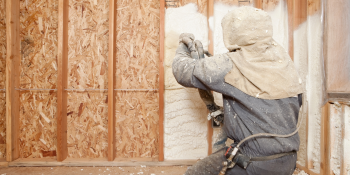Q&A Forums
Sprayfoam vs. Historic Tax Credits Post New Topic | Post Reply
| Author | Comments |
|---|---|
|
Posted: Jun 17, 2010 12:28 PM
|
Sprayfoam vs. Historic Tax Credits
Our firm is engaged in historic tax credit building renovation projects in western Iowa. Contractors seem to like the spray foam roofing product, and it seems to perform well.Our problem is with the Iowa State Historic Preservation Office, as well as the National Park Service. They apparently don't recognize spray foam as a valid roofing product. I'm at a loss as to what to tell them. If there were any spray foam roofing installations that exist today that were installed in 1960 or before, I could reference these as having 'innate historical significance' - I appreciate your short history you gave on the topic (subject: History) in this forum, and might be able to use some data from that to make my case. Otherwise, I would appreciate any information / help / support you could supply me regarding your product. Like I'd said earlier, Contractors seem to like your product, and it does seem to work well, but, because of financing issues, we need to be able to inform the state and federal historic tax credit reviewers of just why your product is fitting for a historic renovation. The particular project I'm talking about has a perfectly-good, in-place spray-foam roof that the Contractor is going to make some minor repairs to, then apply a finish coat over. The SHPO reviewer has said this is not an acceptable practice, and that the spray foam roof needs to be removed and 'an acceptable insulation and roofing material' applied. Help! |
|
jimcoler
I have over 10 years of experience specifying and installing open and closed cell spray foam. I've sold my business but I'm still selling for the new owners and consulting on large and custom specific jobs. I've expanded my knowledge into t Posted: Jun 17, 2010 12:48 PM
|
I would find a new SHPO (whatever that stands for) and plan on repairing it as specified. It seems like we run into these hard headed architects who think they know everything and don't. A spray foam roof system is a great roofing system. You just need to make sure you have a good liner/coating on top of it and it's dry underneath. |
|
mason
Posted: Jun 17, 2010 12:57 PM
|
The earliest SPF roofing applications were installed in the mid 1960s. However, they were using SPF on exterior metal tanks before roofs. For example, my father insulated MEK dewaxing filter (metal tanks) for Exxon at their Baytown, TX plant in 1963. I re-insulated 7 of those tanks in 1993. We were originally supposed to do 17 total but the foam was in perfect condition so they cancelled the contract. Dr Rene Dupuis performed research onSPF roofing systems in 1996 and again in 2002. His conclusion were that "SPF roofing systems are one of the most sustainable roofing systems to date" He inspected and sampled more than 350 SPF roofing systems in 6 different climate zones in the US from Eau Claire, Wisconsin to South Texas and found that a properly installed SPF roofing system has an indefinite life span so long as it is protected with a UV resistant coating. Plus his research noted that SPF roofing systems as of 2003 were recoated on average every 15 years. Please check out the article I just had published in Contractor Specifier (JUNE 2010 issue) on the life cycle costs of a SPF roof compared to membrane roofing systems. It shows that even without considering energy performance that a SPF roof system would typically cost 50% to 100% less to install and maintain over a 30 year life span over a membrane roofing system. |
|
mason
Posted: Jun 17, 2010 01:05 PM
|
By the way I inspect SPF roofs for a living and would be happy to get involved in this particular project. I am SPF accredited and chairman of the ASTM Subcommittee on SPF roofing. |
|
Posted: Jun 17, 2010 02:14 PM
|
This is very helpful - I look forward to reading the article in Contractor Specifier. I am hoping to be able to cite your discussions on this forum, as well as in that article, to make my case to the Iowa State Historic Preservation Office (IA SHPO) as well as the National Park Service. I'm actually surprised this topic hasn't come up before - A portion of financing for the project I'm working on comes from federal historic tax credits (20% of the construction cost) and state historic tax credits (25% of the construction costs). I believe the developer will actually net about 40% of the total construction costs when it's all said and done - I just think it would be a shame to remove a perfectly good roof that is in working order just in the name of 'historical correctness'. Thanks again for the great response. |





























